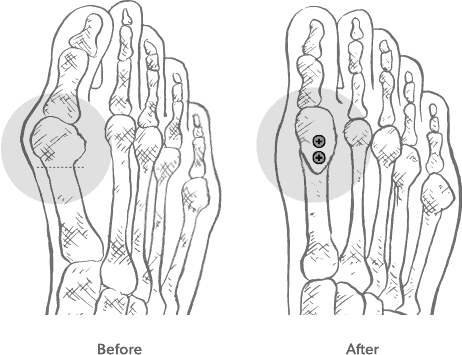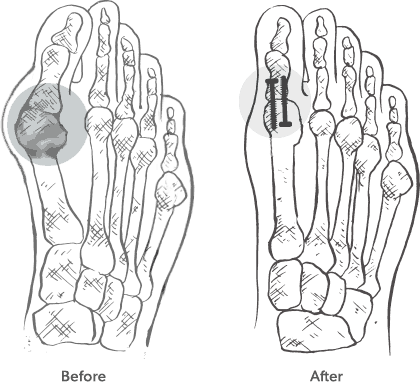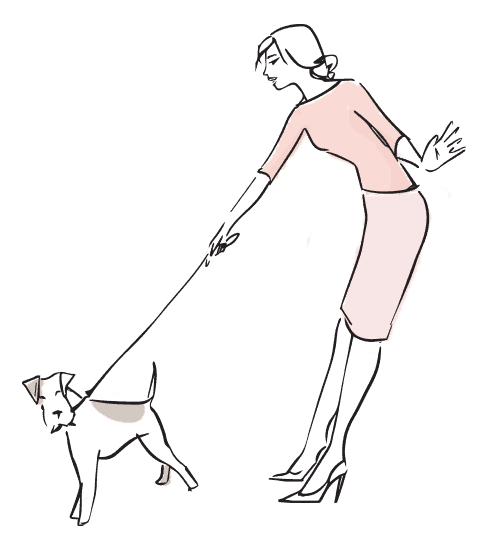Treatment
BUNION FACT # 29
While home remedies can provide temporary relief, the only permanent treatment option for bunions is surgery.
Treatment
When is
it time for surgery?
Many people just know when it’s time to surgically correct their bunion. They’re in pain, they’re sick of thinking about it, and they’re tired of looking at their unsightly feet.
And yes, it would be nice to wear something other than running shoes and open-toed sandals.
For others, it’s a decision that takes years to make. People think they shouldn’t have surgery until in severe pain, so they work around the pain–wearing flip-flops and sneakers–and convince themselves they’re “pain-free”. Or maybe they think their surgery would be for purely cosmetic reasons, which in their minds doesn’t justify it.
If you’ve exhausted non-surgical treatments and you’re still in pain, it’s time to surgically fix the problem. But also if a bunion interferes with your life, whether that means your daily activities, walking, exercise, shoe choice, negative feelings about your feet, you should consider surgery. It’s essentially corrective surgery, since surgery will correct the misalignment of the bones that cause the bunion. Usually it’s a combination of factors–pain, limited activities and emotional issues–that signal it’s time to do something about your bunion.
A consultation from a bunion surgeon will allow you to get an assessment of what is actually going on in your foot and listen to treatment options from a qualified expert.
Mary stands up for her feet
Follow Mary Jordan on surgery day. With the expertise of a vetted surgeon, she's bunion-free in 40 minutes.
What to expect from surgery
The point of bunion surgery is to correct the bone and joint misalignment that caused the bunion.
A bunion surgeon will realign and reset the first metatarsal bone, shave the bone’s outside bone growth, perhaps release the tendon that is pulling the first toe towards the second, and reorganize the soft tissue around the big toe joint. For severe bunions, the surgeon may opt to fuse two bones further back in your foot. He or she can perform bunion surgery under local anesthesia with sedation or under general anesthesia. It’s outpatient surgery done at a hospital or surgery center and in some instances in the doctor’s office. The most common bunion surgery is the Austin type procedure, which can fix a majority of bunions and takes just 40 minutes to do by an experienced surgeon.

Over 50 types of bunion surgery
Depending on your foot’s architecture, your ligament laxity and your specific circumstances, the bunion surgeon will determine which type of surgery will be most successful for you.
In recent years, the bunionectomy has become much more predictable, with an easier recovery. Local anesthesia is longer-acting and bunion surgeons have become proficient, keeping surgical times shorter, so there’s less tissue trauma which means less swelling and less pain.
There are many different types of procedures because bunions themselves are so complex and each person has a different foot architecture. Currently there are more than 50 procedures surgeons choose from. Mostly they are variations on these:
Hallux Valgus

Austin procedure
The Austin, or Chevron osteotomy, is the most common because it is designed for the most common type of bunion…
Which is moderate
A surgical fracture allows the first metatarsal and big toe joint to be realigned into a straighter position. (Often the realignment requires very small screws that hold the bone in place while it heals. This allows for early walking and diminishes pain by stabilizing the fracture.) Sometimes the tendon that is pulling the first toe towards the second is released, letting the big toe to return to a straighter position. The bump, or bone spur, on the outside of the bone is shaved down. Repositioning the metatarsal ensures the bunion doesn’t return. If you’ve heard of cases where the bunion “returns,” that may be because only the bump was shaved down, which alone does not correct the underlying problem.
The Lapidus procedure is for more severe bunions, where the angle between the first and second metatarsal bones is greater than 18 degrees, ligaments are very lax and there is overall hypermobility/instability in the foot joints.
This is a powerful procedure that can correct the most serious of bunions.
It involves fusing the metatarsal cuneiform joint, at the base of the first metatarsal. Approximately 30% of patients require a Lapidus procedure. If you do, you want to make sure your surgeon is very comfortable doing this procedure. This involves a combination of screws, plates and pins, which may or may not be removed after the fusion is complete.
Some people with bunions on both feet opt to have them operated on at the same time, which is called a bilateral bunionectomy. This can be done with the Austin procedure if you have moderate bunions, but usually not with the Lapidus.

Lapidus procedure
Hallux Rigidus

1. Cheilectomy is when the bone spurs around the big toe joint, called osteophytes, are removed through surgical shaving.
These osteophytes are what cause pain as they are irritated by shoes and they also block motion, preventing the big toe from moving freely. Sometimes, realigning the first metatarsal bone is necessary too.
2. If the joint is completely devoid of cartilage, a surgeon can resurface the bones within the joint by performing an Implant Arthroplasty
…replacing the joint with a titanium implant, much like a knee or hip replacement.
3. An Osteotomy realigns the big toe joint in an effort to decompress the joint and allow for more joint motion.
4. In severe cases of hallux rigidus, a surgeon will perform a Joint Fusion of the big toe joint.
This involves removing the diseased cartilage and fusing the bones together. Even though these patients will not be able to move their big toe joint after the operation, they are usually very happy with the result since the small amount of motion they had before surgery was extremely painful.

Joint Fusion
Bunionette

Bunionette / Tailor's Bunion
For these bunions on the pinky toe side of the foot, a surgeon will shave the bump and also perform an osteotomy, similar to the Chevron or Austin.
Treatment
How to prep for surgery
When you go for a consultation with a bunion surgeon, he or she will take X-rays and ask you about your health history.
A physical exam will reveal the general mechanics of your foot, including hypermobility in the joints and/or irregular or restricted joint motion.
After assessing the biomechanics and existing misalignment of your bones, the doctor will explain the various procedures and suggest which one is right for you. He will describe the recovery period including what to expect post-surgery, after a few months, and when you’ll be able to wear shoes, drive, exercise and expect a full recovery.
Once you decide to move forward, you will schedule the surgery with the doctor’s office. Every surgeon is different, but most require blood work prior to surgery to be certain that you are in optimal health to have and recover from surgery. Some surgeons will not operate if you are a smoker or are very heavy, since both of these conditions may cause unwanted complications and prevent a successful outcome.
Here are a few things to prepare for surgery and recovery:
- Buy a waterproof shower protector (you won’t be able to get your foot wet for a couple of weeks)
- Fill antibiotic and painkiller prescriptions
- Shop for a few days’ worth of meals
- Make arrangements for walking your pets
- Ask a friend or family member to pick you up from surgery
- Prepare emotionally, you may feel anxiety and/or relief
- Don’t eat or drink anything after midnight the night before surgery

Treatment
Will my insurance cover this?
Insurance coverage for bunion surgery varies according to the plan, so make sure to call your insurance carrier to find out what they will and will not cover. Some insurance carriers will cover “in network” surgeons only, which may leave you with a doctor of their choosing.
Make sure you see a surgeon who specializes in bunion surgery, not just foot and ankle surgery and not just orthopedics.
You want a surgeon who has the ability to figure out what is causing your particular bunion, and the experience to provide the customized treatment that’s right for you. Sometimes the most qualified doctors are ‘out of network’. If the doctor you’ve chosen isn’t covered by your insurance, he or she may offer interest-free financing to cover the cost of your procedure.
Even if your insurance carrier doesn’t cover the surgeon’s fee, they may cover the surgical center, hospital, and the anesthesiologist’s bill, depending on your health insurance plan.
Most bunion surgeons offer some type of interest free financing and bunion surgery is usually quite affordable.
